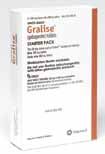Publication
Article
Pharmacy Times
New FDA Actions: Depomed Inc's Gralise
Author(s):
The FDA appoved Gralise (gabapentin) for the management of postherpetic neuralgia in adult patients.
The FDA appoved Gralise (gabapentin) for the management of postherpetic neuralgia in adult patients.

The FDA has granted approval to Depomed Inc’s Gralise (gabapentin) for the management of postherpetic neuralgia (PHN) in adult patients. The approval specifies that Gralise is not interchangeable with other formulations of gabapentin, as the pharmacokinetic profiles of these formulations differ, which affects the frequency of administration.1 Gralise uses Depomed’s patented polymer technology to ensure a gradual release of the medication. It is estimated that approximately 1 million Americans experience shingles each year, and of the individuals affected by the condition, 1 in 5 will develop PHN.2
Pharmacology and Pharmacokinetics
The exact mechanism of action of Gralise is unknown. It is structurally related to the neurotransmitter gamma-aminobutytic acid (GABA). In neuropathic pain models of rats and mice, gabapentin prevents allodynia, hyperalgesia, and pain-related responses. It decreases pain-related responses after peripheral inflammation, but does not change immediate pain-related behaviors.
The rate and extent of absorption of Gralise is increased with concomitant administration of food. Because it is not metabolized, Gralise has not been studied in patients with hepatic impairment. Gralise undergoes renal excretion, and dose adjustments are required for patients with renal impairment. The clearance of Gralise appears to decrease as age increases; however, this may be related to an age-related decrease in renal function. The effect of gender on the pharmacokinetics of Gralise has not been formally studied, but it appears that the pharmacokinetic parameters are similar for men and women. Race does not appear to affect the pharmacokinetics of Gralise.1
Dosage and Administration
Gralise should be titrated to 1800 mg taken once a day with the evening meal. The initial titration schedule is as follows:
Day 1: 300 mg
Day 2: 600 mg
Days 3 to 6: 900 mg
Days 7 to 10: 1200 mg
Days 11 to 14: 1500 mg
Days 15 and beyond: 1800 mg
The tablets should be swallowed whole; Gralise should not be split, crushed, or chewed. Patients with a creatinine clearance (CrCl) of 30 to 60 mL/min should receive a decreased dose of 600 to 1800 mg per day; patients with a CrCl less than 30 mL/min or those receiving hemodialysis should not use Gralise. When discontinuing, reducing, or substituting the dose of Gralise, a week-long taper should occur.1
Clinical Trials
Gralise was evaluated in a double-blind, placebo-controlled, multicenter study of 452 patients ranging from 21 to 89 years of age. Study participants experienced PHN that persisted for at least 6 months after the healing of the rash and had a minimum baseline pain intensity score of 4 on an 11-point numerical pain rating scale ranging from 0 (no pain) to 10 (worst possible pain). The dose of Gralise was titrated to 1800 mg a day. Patients in each group recorded their pain daily, using the 11-point numerical pain rating scale. At the end of the 11-week study, a statistically significant improvement was found in the Gralise arm compared with the placebo arm.1
Contraindications, Warnings, and Precautions
Gralise is contraindicated in patients with a hypersensitivity to the medication or any of its components.
Gralise is not interchangeable with other formulations of gabapentin. Antiepileptic medications, including gabapentin, may increase the risk of suicidal thoughts or behaviors. The safety and efficacy of Gralise in patients with epilepsy has not been studied; however, increased seizure frequency may occur if the dose is rapidly discontinued. The dose of Gralise should be tapered over at least 1 week before completely discontinuing the medication.
An increase in the area under the plasma concentration-time curve of gabapentin has been reported when administered with hydrocodone or morphine. When used concomitantly with antacids containing aluminum hydroxide and magnesium hydroxide, Gralise should be taken at least 2 hours after antacid administration.
Gralise is pregnancy category C. It is excreted into human breastmilk and should only be used by nursing women if the benefits clearly outweigh the risks. A dose adjustment is required for patients with renal impairment. Elderly patients with impaired renal function may require a decreased dose. Gralise is not approved for use in pediatric patients.1
The most commonly reported adverse effects were dizziness, somnolence, and peripheral edema.2 PT
Dr. Holmberg is a pharmacist who resides in Phoenix, Arizona.
References
1. Gralise complete prescribing information. www.gralise.com/lib/PDFS/FPI_APR2011.pdf. Accessed November 2011.
2. Depomed announces new once-daily gralise now available for after-shingles pain. http://investor.depomedinc.com/phoenix.zhtml?c=97276&p=irol-newsArticle&ID=1615369&highlight. Accessed November 2011.







